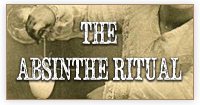Absinthe.se
The premier independent absinthe resource since 2003
Musset didn't write the way he did because he drank absinthe, instead he drank for the same reason for which he wrote just like that: namely out of despair.
Tjänstekvinnans Son
(The Son of a Servant)
Modern revival of absinthe
In the 1990's absinthe made a come-back in stores across Europe. Some of the modern revival reminds of absinthe's old history in many ways, only today science is a little more exact. Read here to learn how absinthe came back not only to Europe but the USA as well as Asia.
It would be around 80 years before absinthe became widely known and spread across Europe once again after the French ban in 1915.
1988 marked the time when absinthe would actually be made legal in most of the EU member countries according to new EU regulations regarding food additives. This regulated thujone content in food and beverage and indirectly made absinthe legal again. Only a few countries that had previously specifically banned the drink by law still kept the ban active. Likely because no one took notice and bothered to revoke those laws.
During the second half of the 1990's Czech liqour manufacturers realized absinthe was never banned in their country and they started making and selling absinthe. Hill's made their Hill's Absinth around 1997 and this was to be one of the main players in the revival of absinthe. The Czech style, or "Bohemian style absinthe", had quite little in common with the original absinthes of old but never the less they did make way for a lot to come.
BBH Spirits, based in the UK, also noticed that absinthe had never been legally banned in the UK and in 1998 they imported and distributed a Czech style absinthe in the UK.
Czech absinth floods the market
With the La Fée Bohemian becoming a success in the UK more Czech manufacturers started to produce absinthe. Again, sadly most of them were very far from real absinthe and were made either by mixing essences, colorants and high proof liqour or simply by steeping herbs in high proof spirits and then bottling it. Prices were high and - in a way unfortunately - so was demand. The boom of Czech absinth on the market created rumours that the only real absinthe to be found was of course Czech absinth. Nothing could be further from the truth.
Eventually higher quality products started to emerge from other parts of Europe and once again Spanish absentas came back to life. Having lived a quiet life for a while they were back. Even though they too were mainly essence mixes colored with artificial colorants they resembled a true absinthe much more than the Czech products.
At the other side of the globe, in Japan, absinthe had been available for quite some time. Produced by Japanese liqour manufacturer Suntory, an absinthe named Hermes had been available from the 1950's all the way up to the end of the 1980's. Seeing how demand for it had faded over the years, Suntory seized production of the Hermes absinthe in 1987.
Absinthe enthusiasts enter the scene
Across the globe absinthe enthusiasts followed the market and demanded higher quality, knowing how real absinthe was originally made. Around the year 2000 UK based company Liqueurs de France made one of the first serious attempts at making a traditionally distilled, comercial scale, absinthe - the Un Emile. Produced at the Les Fils d'Emile Pernot distillery in Pontarlier, France this was a huge leap forward. In the same town the Guy distillery started making their Francois Guy absinthe. The Guy was a lower alcohol level of only 45%, compared to most others that were around 60-70%. The Guy absinthe was less complex in profile compared to the Un Emile but suddenly having two traditionally made absinthes coming out of France made a big difference.
Now manufacturers all across France started making absinthes. Some good, some not, but the important thing was to have better products on the market.
Just before 2000 the Pernod-Ricard company had produced an essence based absinthe by the name Oxygenée. The name, and label, referring to the old fine brand of absinthe by the Cusenier company, a name now owned by Pernod-Ricard. The modern version was nowhere near real pre-ban absinthe and in 2001 the production of the Oxygenée was terminated. Instead they had introduced a new Pernod Absinthe on the market. The only downside was that the Pernod absinthe was in fact less tasty than the Oxygenée and bare no resemblance to the once groundbreaking Pernod Absinthe of the Belle Epoque. In 2013 Pernod-Ricard released a reworked version of their modern Pernod Absinthe, supposedly based on the original Pernod recipe. I doubt that is all true, but it is atleast distilled using Pontarlier Wormwood and that's a good thing.
An ever increasing market and demand of course triggered makers in other countries to follow. German manufacturers suddenly started to mass produce absinthes. The downside was that the vast majority of them were of the same sad quality as the Czech and most Spanish absinthes.
Spreading across Europe
Around 2004-2006 a lot happened in the absinthe world. Both the Netherlands and Belgium removed their own laws prohibiting absinthe to once again let the green fairy land in bars and stores there. What's more important during those years was that at March 1st, 2005 Switzerland once again allowed for the sale and manufacture of absinthe. After 95 years of ban (and almost as many years of bootlegged absinthe coming out of Switzerland) it was finally legal to make absinthe where it all first started.
Many of the former clandestine distillers applied for permits and are now legally producing Swiss absinthe. Most Swiss absinthe are so called Blanches. That is uncolored absinthe. They also tend to be heavier on anise and fennel. Not all Swiss absinthe is white though and in the little town of Kallnach a family distillery, Matter-Luginbühl, produces some of the finer absinthe vertes on the market today.
Even some Czech producers started making traditionally made absinthe and suddenly there was amazingly good Czech absinthe to be found, the St. Antoine by Zufanec.
The United States of America wants a little green too
Across the Atlantic ocean, in the US, absinthe was still "technically" illegal. This regulation was now being challenged by distillers and distributors. With scientific studies, facts and the European legislation to back their case the American authorities were approached from two directions. In 2007, independent of each other, representatives from Lucid (French made absinthe - the first to hit shelves in the US) and Swiss absinthe maker Kübler finally had absinthe made legal in the US again.
In late 2007 the first US made absinthe, St. George Absinthe Verte, was released in California from the St. George distillery. Many more have followed and plenty of high quality absinthes can now be found in the US again. Micro distilleries have emerged all over the country. Of course not only because of the re-legalization of absinthe but many of them do produce absinthe. Distilleries like Leopold Bros. with their Leopold Absinthe Verte, Pacific Distillery with the Pacifique and many more.
Absinthe is in full bloom, what's next?
With an ever increasing market and with absinthe becoming more and more of a generally available drink something new is bound to happen. So, what could be better than to pair it with the ongoing trend of finer cocktails in the bars across the world?
Absinthe today is much more than the tourist absinthe shots on fire in Prague. The world's finest establishments have taken the wonderful drink in and mixologists create the most amazing cocktails using absinthe. Starting with the Sazerac cocktail in New Orleans in the late 1880's there have been many cocktails with absinthe before but with the cocktail trend of today we can only imagine what will come out tomorrow.
Limits and regulations on absinthe
Even though absinthe once again is legal in most parts of the world there are still restrictions and regulations on absinthe and its contents. Apart from the obvious that illegal substances may not used in the finished product there are a couple of other regulations in place. The most notable is of course the restriction on thujone content.
Regulations within the EU
In the EU regulations state that alcoholic beverages produced from Artemisia species (formerly defined as bitters) may contain up to 35ppm thujone. Alcoholic beverages other than those produced from Artemisia species may contain up to 10ppm. Non-alcoholic beverages may contain only 0.5ppm. In other words, absinthe may contain up to 35ppm thujone.
Regulations in Switzerland
In Switzerland the same levels as stated by EU legislation for alcoholic beverages produced from Artemisia species have been adapted and absinthe in Switzerland may contain up to 35ppm thujone. Switzerland have taken regulations for absinthe a bit further though and even state that an absinthe in Switzerland must be distilled and naturally colored. No faux absinthes...
Regulations in the USA
In the US things are a bit different. What the "re-legalization" in 2007 actually meant wasn't that absinthe in particular was made legal. Instead what was questioned was the FDA rules for thujone content. The regulations states that food or beverages that contain any Artemisia species must be thujone free. As of 2007 "thujone free" in reality means up to 10ppm. In other words US regulations meet EU regulations for non-artemisia beverages.
Written by Markus Hartsmar
- absinthe books and poetry -
Many writers "of old" wrote poems or passages about absinthe. Some drank it, some didn't. Find some of them here as well as reviews and notes on modern books about absinthe.
- latest news and additions -
The Absinthe Poetry section has seen several updates the past days. Poems and information about more authors; Antonin Artaud, Arthur Symons, Francis Saltus Saltus, Florence Folsom and Robert Loveman. Open your mind and have a drink while you enjoy their lyrics.
Read more...
- absinthe.se on facebook -
It's the new bistro, the new bar in town. A good place to meet when meeting in real life isn't always an option. Meet me on facebook for more updates from the absinthe world.

